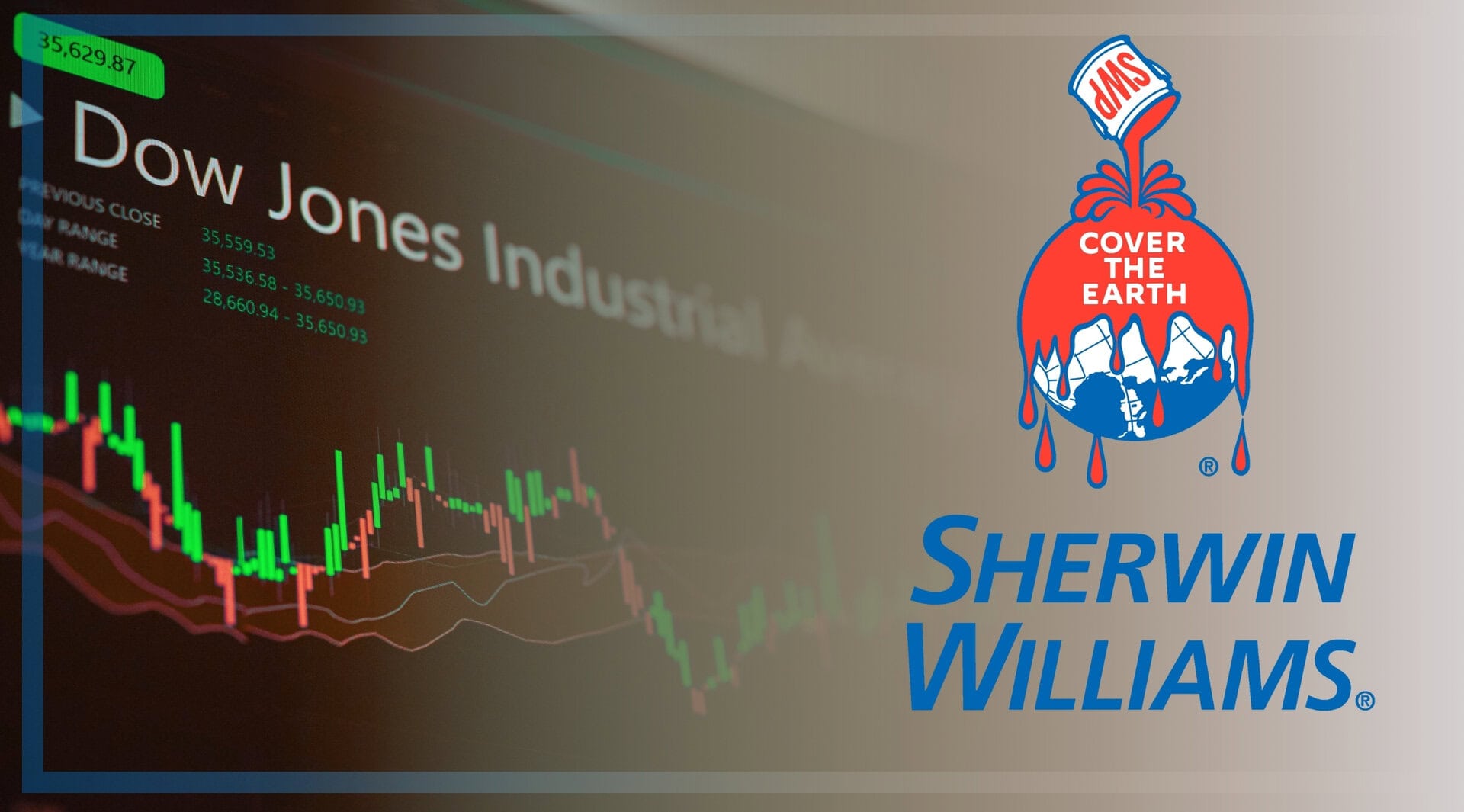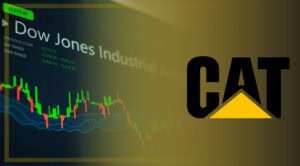Sherwin-Williams (ticker: SHW) entered the Dow Jones Industrial Average (DJIA) in 2024, joining the 30-stock roster of America’s market leaders. The index added Sherwin-Williams (alongside Nvidia) effective November 8, replacing Intel and Dow Inc. in a reshuffle aimed at better representing the materials sector. Unlike some legacy members, Sherwin-Williams’ inclusion affirms its status as a modern powerhouse in paints and coatings.
Disruption Banking examines Sherwin-Williams’ journey so far — both prior to its Dow inclusion and after — offering investors insights into SHW’s performance and where it may be “painting” next.
A Decade of Outperformance in the Dow Jones
In the decade before joining the DJIA, Sherwin-Williams delivered remarkable returns. From late 2015 to this year, SHW’s total return was roughly 369 percent, far outpacing the Dow’s return of roughly 174 percent, more than tripling in value over that period, according to Statmuse. Over the ten years ending August 2025, Sherwin’s return beat stalwarts like Home Depot (340 percent) and McDonald’s (roughly 316 percent). This spectacular run reflects Sherwin-Williams’ steady growth and investor confidence.
Since inclusion, shares have traded near record highs, with an all-time closing high around $397 in November 2024 amid optimism surrounding its Dow debut, per Macrotrends. As at the time of writing, SHW’s price is roughly $366 (TradingView) — well above 2013–2014 prices under $80, and about 150% higher than its price in 2015.
Yet, volatility has been part of the story. A peak near $340 in late 2021, a −32 percent slide in 2022, a +32.7 percent rebound in 2023, further gains in 2024 (+9.9 percent) and YTD 2025 (+8% through August).
Big annual swings — +49.7 percent in 2019, +44.9 percent in 2021, −31.9 percent in 2022 — mirror sensitivity to housing and industrial cycles.

Sherwin-Williams (SHW) Annual Average Stock Price. Source: Macrotrends
Navigating a 2025 Reset
After years of expansion — including the transformative $11.3 billion Valspar acquisition in 2017, according to a JonesDay report — Sherwin-Williams entered a 2024–2025 reset. Management flagged “choppy” demand and rising costs in the first half of this year; CEO Heidi Petz cautioned that a Q2 slowdown could extend into the second half. The 157-year-old Dow Jones firm (founded in 1866) reported that Consumer Brands segment revenue fell 4% in Q2 on weak do-it-yourself paint sales even as its professional Paint Stores segment grew modestly by raising prices.
Margin pressure from elevated Sales, General, & Administrative (SG&A) costs led to a profit miss and prompted Sherwin-Williams to trim its full-year 2025 EPS guidance. The company accelerated restructuring actions — doubling its projected cost savings to $105 million — and continues to rely upon its expansive paint store network (over 5,400 stores) as a resilient revenue foundation while demand remains soft.
Best performing stocks of the last 40 years and their max drawdowns
— Brad Kaellner (@bkaellner) August 19, 2025
You'll appreciate this one @chriswmayer
Sherwin-Williams is the only stock to have a max drawdown lower than the S&P 👀 pic.twitter.com/XDijjxEWLQ
Wall Street’s Confidence in SHW
Sherwin-Williams’ dividend record — 47 consecutive years of increases — speaks to durability. As of August 2025, SHW’s dividend yield is approximately 0.86 percent (Macrotrends), reflecting a growth-first capital allocation that also includes buybacks.
As a price-weighted Dow Jones component, SHW’s mid-$360s share price gives it a moderate Dow impact. It sits in the index’s top 5 tier by weight, just under 5% per Slickcharts as at the time of writing.
SHW’s inclusion brings a purer materials and housing barometer into the DJIA mix after the removal of Dow Inc., giving investors a window into Main Street demand within the blue-chip lineup.
Challenges: Lawsuits and Economic Cycles
Legacy legal risk remains a watch item. Like paint peers, Sherwin-Williams has faced lawsuits tied to historic lead-based paint. A 2019 Wisconsin verdict found several firms, including Sherwin-Williams, liable for childhood exposure injuries, and the company has participated in settlements, including a 2014 California settlement requiring lead paint abatement funding.
Another challenge — and opportunity — is Sherwin-Williams’ reliance on the broader economy, especially the housing and construction cycles. When mortgage rates rise sharply (as they did in 2022–2023), home sales and home renovations tend to cool, which softens paint demand. Conversely, lower rates or government infrastructure spending can stimulate Sherwin’s sales and invariably shake its Dow Jones standing.
Geopolitics and raw material inflation also loom. Sherwin-Williams depends on various petrochemical inputs for coatings, so oil price swings or supply chain disruptions can affect margins. Sherwin’s scale helps negotiate supply and selectively pass through price increases, but maintaining price/volume balance in an inflationary backdrop is delicate.
Outlook: Balancing Growth and Stability
Analysts and management generally expect Sherwin-Williams to navigate its current slowdown and resume steady growth in the coming years. The near-term focus is on preserving profitability through cost discipline until demand rebounds. Sherwin’s updated forecast for 2025 states that “we expect third quarter 2025 consolidated net sales to be up or down a low-single digit percentage compared to the third quarter of 2024.”
If the U.S. economy escapes a severe recession and housing stabilizes in 2026, Sherwin-Williams could see reaccelerating sales as pent-up home improvement projects and construction activity revive.
In the long run, Sherwin-Williams is betting on innovations like developing more eco-friendly paints to drive new business, aiming to outpace the market through differentiation.
Investment Takeaways
For investors, Sherwin-Williams presents a mix of stability and cyclicality. Its long dividend growth streak and dominant market position provide confidence in the firm’s resilience. Yet the stock’s somewhat high valuation and low dividend yield reflect a growth premium that can be tested during economic lulls.
As a relatively new Dow Jones component, Sherwin-Williams will be closely watched as a barometer of the construction and consumer spending climate. If homebuilding and renovation pick up steam, the company’s revenues and earnings could paint an even brighter picture; if inflation and interest rates restrain activity, Sherwin may have to content itself with modest gains for a while.
#CapitalMarkets #SHW #DowJones #DJIA
Author: Richardson Chinonyerem
The editorial team at #DisruptionBanking has taken all precautions to ensure that no persons or organizations have been adversely affected or offered any sort of financial advice in this article. This article is most definitely not financial advice.
See Also:
Nike in the Dow Jones: Running With Wall Street | Disruption Banking
3M in the Dow Jones: from Innovation to Tribulation | Disruption Banking
Amgen: Biotech Pioneer’s Dow Jones Journey | Disruption Banking














